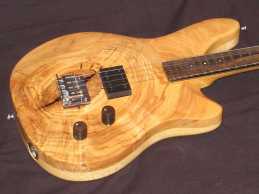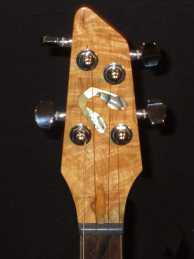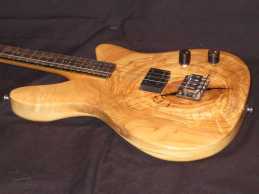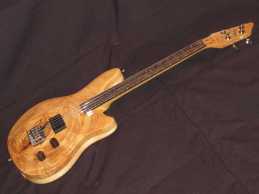 I've
been salvaging local woods for almost as long as I've been building
guitars. If the I've
been salvaging local woods for almost as long as I've been building
guitars. If the grains is straight and the log is big enough, then I cut it into acoustic
guitar back and side sets, but if the grain is wild, then often it turns
out to be perfect for an electric guitar. That's the case with this
little cross cut slab of Maple. It was in my stach for years.
I was blown away with the color - showing some light spalting, by the
stress flame radiating out form the center, the patern of the rings, and
even the void in the pith along with the checking. I'd pick it up
from time to time and tap it. It rang like a bell. It was
calliung out to become one of my little mini guitars.
grains is straight and the log is big enough, then I cut it into acoustic
guitar back and side sets, but if the grain is wild, then often it turns
out to be perfect for an electric guitar. That's the case with this
little cross cut slab of Maple. It was in my stach for years.
I was blown away with the color - showing some light spalting, by the
stress flame radiating out form the center, the patern of the rings, and
even the void in the pith along with the checking. I'd pick it up
from time to time and tap it. It rang like a bell. It was
calliung out to become one of my little mini guitars.
I took this
maple slab and paired it up with more salvaged Basswood from my own
property. The back is bookmatched and also showing some flame, which
is very uncommon in Basswood. The neck is made of Black Locust,
which is a member of the same family of plant life as Rosewood, and has
overlapping qualities, making it Canada's golden tonewood. The only
exotic woods are the
Zericote fret board and the Ebony  binding. Zericote is equal to Ebony as a fret board but also has
those wild color paterns making it visually perfect to be paired up with
this maple top.
binding. Zericote is equal to Ebony as a fret board but also has
those wild color paterns making it visually perfect to be paired up with
this maple top.
The neck of this instrument has an 18.5" scale length,
which is about where the 7th fret is located on a standard sized guitar.
Thats the note B on the first string - a perfect 5th musically. So
this instrument is tuned up a 5th to
A, D, F#, B. The string spacing is just like a standard electric
guitar, making the Nut much narrower than an equivilant sized Ukulele.
The string height is also very low, giving people the ability to play much
faster than they are used to.
Finally, I had a conversation with
Kent - the owner of Kent Armstrong Pickups - and ordered custom hand made
humbuckers with the exact pole placement for the layout of this guitar.
These were made with four leads allowing for
series / parallel switching via a push / pull on the tone knob.
I'm pleased to say that this guitar has the same great clarity and sustain
as all Dickert Guitars. Pushing the switch down into series, ups the
gain and drives the amp to give some serious growl. Playing the
first string past the 12th fret reminds you of those eightieth keys on a
grand piano.
 Further
notes; The knobs are hand made Zericote wooden knobs with a MOP
possition dot on top. They have brass bushing in the center, and an
allen key set screw. Further
notes; The knobs are hand made Zericote wooden knobs with a MOP
possition dot on top. They have brass bushing in the center, and an
allen key set screw.
The head stock inlay is a Maple Key made of Gold MOP
and Abalone, inlayed into the head cap which is made from the same wood as
the guitar's Maple top.
The void in the center of the Maple top was filled
with the same kind of epoxy used in creating "River Tables". I use
Ebony saw dust mixed into the epoxy to give it that deep black color.
This same mix was used in all the checks and voids, stabalizing everything
and giving it that great look.

|
![]()
![]()